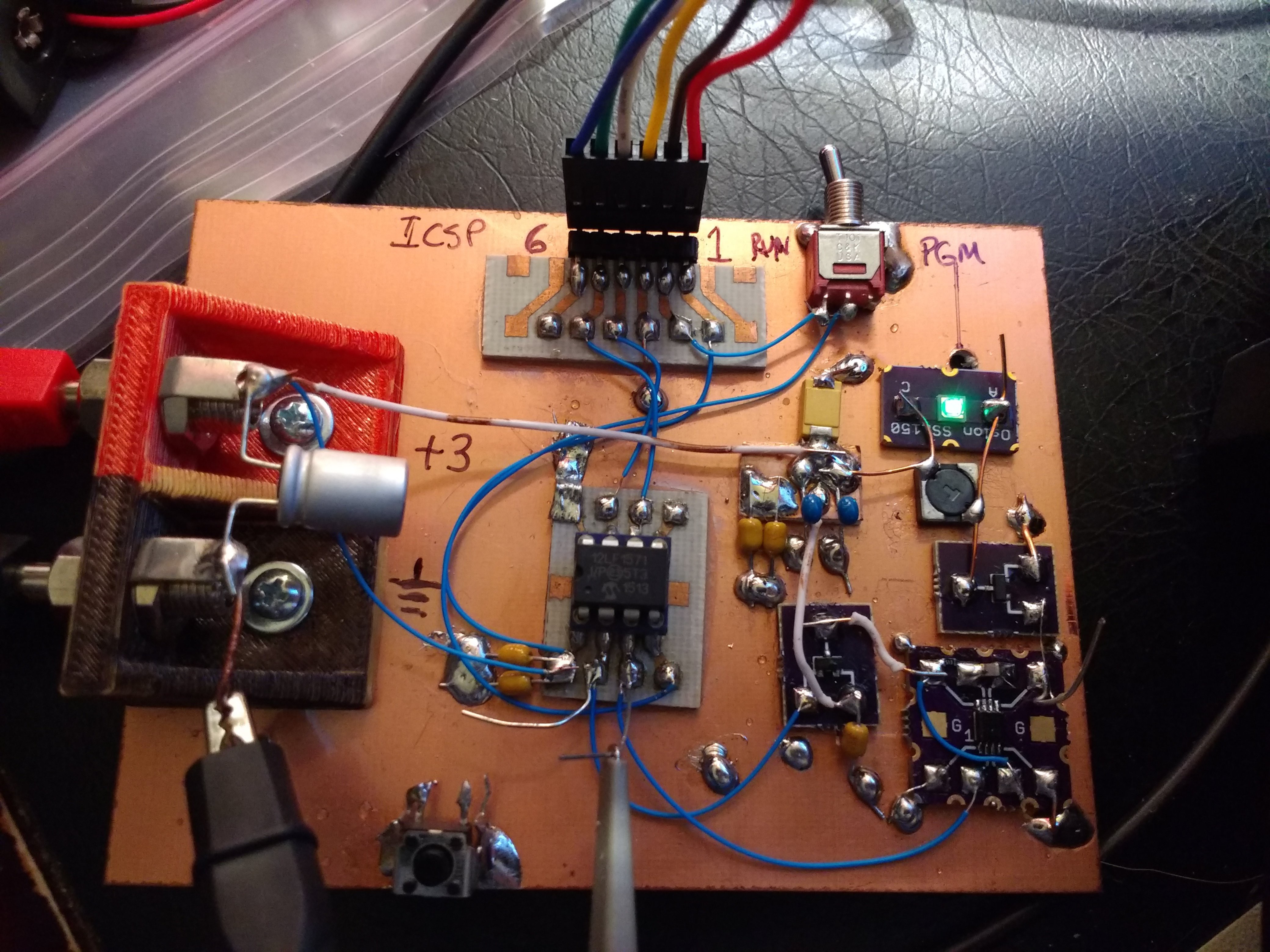I prototyped the V3.0 circuit, re-using one of the V2.x breadboards. A few #Ugly SMD Adapters hold the 74LVC1G123 monostable, OSLON Signal Verde LED and SOT23 MOSFETs.

I tested the circuit at various pulse frequencies, and fit a line to the current drain. The resulting equation is:
where f is the pulse frequency. Since there is a fixed cost of 1.15uA, the circuit is more efficient for higher frequencies (larger current drains and brighter LED). This equation is close enough to get you in the ballpark when tuning for a specific current drain (or lifetime), but then you may need to tweak the frequency by a Hz or two to fine-tune.
Using the above equation and some manual fine-tuning, I came up with the following pulse frequencies for various run-times with a CR2032 cell. The cell capacity is assumed to be 220 mAh, and the run-time calculated as:
| Frequency (Hz) | Current (uA) | Runtime (years) | Notes |
| 262 | 25.0 | 1.0 | |
| 123 | 12.4 | 2.0 | |
| 78 | 8.15 | 3.1 | |
| 55 | 6.12 | 4.1 | |
| 42 | 4.96 | 5.1 | just flickering |
| 32 | 4.06 | 6.2 | noticeable flicker |
| 26 | 3.53 | 7.1 | noticeable flicker |
| 21 | 3.07 | 8.2 | noticeable flicker |
| 17 | 2.71 | 9.3 | noticeable flicker |
| 14 | 2.43 | 10.3 | noticeable flicker |
| 1 | 1.24 | 20.24 | exceeds shelf life |
I threw in that last point (1Hz pulse rate) just because it's the limit of the code as currently written. Since the shelf life of CR-series cells is commonly taken to be 10 years, I don't think run-times beyond that point make sense to predict.
Of course, the frequencies shown here are just examples chosen to correspond roughly to integer year run-times. You are free to choose any frequency in between or exceeding these. As a test, I turned the frequency up to 5kHz (it measured 4.65 kHz on the scope), and the circuit consumed 405uA. The LED was very bright.
The brightness at 1- and 2-year run-rates seems equivalent to the V2.0 circuit with the single LED I've tested so far.
Here's the PIC code. It's not in GitHub yet. The code just sets up the PWMs and then goes to sleep. The WDT is set for a 256-second timeout, at which point it wakes and the PIC resets to re-initialize the state just in case some bits rot over the years.
;;;
;;; tritiled_v30.asm:
;;; PIC12LF1571 code for CR2032-powered LED glow marker
;;;
;;; 20171227 TCY
LIST P=12LF1571
#include <p12lf1571.inc>
;;;
;;; adjustable pulse frequency parameter
;;;
FREQ equ .123
;;; calculated and fixed parameters
PHASE1 equ .0
PHASE2 equ .0
DUTY_CYCLE1 equ .2
DUTY_CYCLE2 equ .1
OFFSET_COUNT equ .1
PERIOD_COUNT equ (.31000 / FREQ)
ERRORLEVEL -302
ERRORLEVEL -305
ERRORLEVEL -207
__CONFIG _CONFIG1, _FOSC_INTOSC & _WDTE_ON & _PWRTE_OFF & _MCLRE_OFF & _CP_OFF & _BOREN_OFF & _CLKOUTEN_OFF
__CONFIG _CONFIG2, _WRT_OFF & _PLLEN_OFF & _STVREN_OFF & _BORV_HI & _LPBOREN_OFF & _LVP_ON
ORG 0
RESET_VEC:
nop
nop
nop
nop
INTERRUPT_VEC:
BANKSEL ANSELA
movlw b'00000000' ; all digital I/O
movwf ANSELA
BANKSEL LATA
clrf LATA
BANKSEL TRISA
clrf TRISA ; set all lines as outputs
BANKSEL WDTCON
movlw b'00100101' ; WDT 256s timeout
movwf WDTCON
BANKSEL APFCON
movlw b'00000011'
movwf APFCON
BANKSEL PWM1CON
movlw b'00100001' ; PWM2 triggered with PWM1
movwf PWM2OFCON
movlw HIGH(PHASE1)
movwf PWM1PHH
movlw LOW(PHASE1)
movwf PWM1PHL
movlw HIGH(PHASE2)
movwf PWM2PHH
movlw LOW(PHASE2)
movwf PWM2PHL
movlw HIGH(DUTY_CYCLE1)
movwf PWM1DCH
movlw LOW(DUTY_CYCLE1)
movwf PWM1DCL
movlw HIGH(DUTY_CYCLE2)
movwf PWM2DCH
movlw LOW(DUTY_CYCLE2)
movwf PWM2DCL
movlw HIGH(PERIOD_COUNT)
movwf PWM1PRH
movlw LOW(PERIOD_COUNT)
movwf PWM1PRL
movlw HIGH(PERIOD_COUNT)
movwf PWM2PRH
movlw LOW(PERIOD_COUNT)
movwf PWM2PRL
movlw HIGH(OFFSET_COUNT)
movwf PWM1OFH
movlw LOW(OFFSET_COUNT)
movwf PWM1OFL
movlw b'00000011'
movwf PWMLD
movlw b'00000010'
movwf PWM2CLKCON
movlw b'00000010'
movwf PWM1CLKCON
movlw b'00000000'
movwf PWM1OFCON
movlw b'11010000'
movwf PWM1CON
movlw b'11000000'
movwf PWM2CON
sleep ; halt here - PWM generates pulses
reset
;; fill remainder of program memory with reset instructions
fill (reset), 0x03fe-$
END
 Ted Yapo
Ted Yapo
Discussions
Become a Hackaday.io Member
Create an account to leave a comment. Already have an account? Log In.